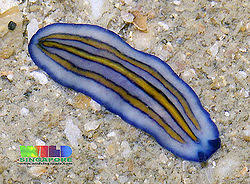Platyhelminthes
Platyhelminthes

Overview
Platyhelminthes also known as acoelomate flatworms are triploblastic organisms[1]. These flatworms can either be commensal or parasitic. These flatworms are divided into four different classes: Turbellaria, Monogenea, Trematoda and Cestoda[3].
Description
Platyhelminthes are Triploblastic which means that these organisms are composed of three fundamental cell layers. The three layers are derived from embryonic germ layers and are known as the ectoderm, mesoderm, and endoderm[2]. These flatworms also have no body cavities other than their gut where they have a 2 way digestive system[1]. A two way digestive system means that their food and excretions come out of the same orifice or opening.
Turbellaria
This class of flatworms is typically free-living and aquatic. Although, there are some turbellaria that can live on land but the conditions must be moist and humid[4]. Free-living means that they do not need to parasitize a host for survival, unlike some of the other flatworms. These specific flatworms can range anywhere from a few millimeters to up to half a meter long[4]. Turbellaria are also hermaphrodites'. They contain both sperm and egg cells which are fertilized inside their body cavity. They fertilize the eggs by copulation, a process where the sperm is directly inserted into the females reproductive system[5].
Monogenea
Monogenea are ectoparasitic flatworms which are usually found on the fins, gills and scales of fish. They range from 5 millimeters up too several centimeters long but no longer than 10cm. Their lifecycle is the simplest among all platyhelminthes due to the fact that they do not have a need for an intermediate host to continue their lifecycle. Their eggs hatch in water and their larvae are known as oncomiracidium[6]. These oncomiracidium are heavily ciliated which allows them to move through the water to find and attach to a host. Before they can start maturing Monogenea need to use their posterior hooks to attach to their prey.
Trematoda
Cestoda
Citations
[1] Introduction to the Platyhelminthes, ucmp.berkeley.edu/platyhelminthes/platyhelminthes.html.
[2]Neupane, Laxmi, and Keerthana. “Phylum Platyhelminthes- Characteristics, Classification, Examples.” Microbe Notes, 25 Aug. 2020, microbenotes.com/phylum-platyhelminthes-flatworms/.
[3] Learning, Lumen. “Biology for Majors II.” Lumen, courses.lumenlearning.com/wm-biology2/chapter/phylum-platyhelminthes/#:~:text=Platyhelminthes are traditionally divided into,and Cestoda (Figure 2).
[4] “Class Turbellaria(Flatworms).” Class Turbellaria, jupiter.plymouth.edu/~lts/invertebrates/Primer/text/turbellaria.html.
[5] “Turbellaria.” Wikipedia, Wikimedia Foundation, 20 Jan. 2021, en.wikipedia.org/wiki/Turbellaria
[6]